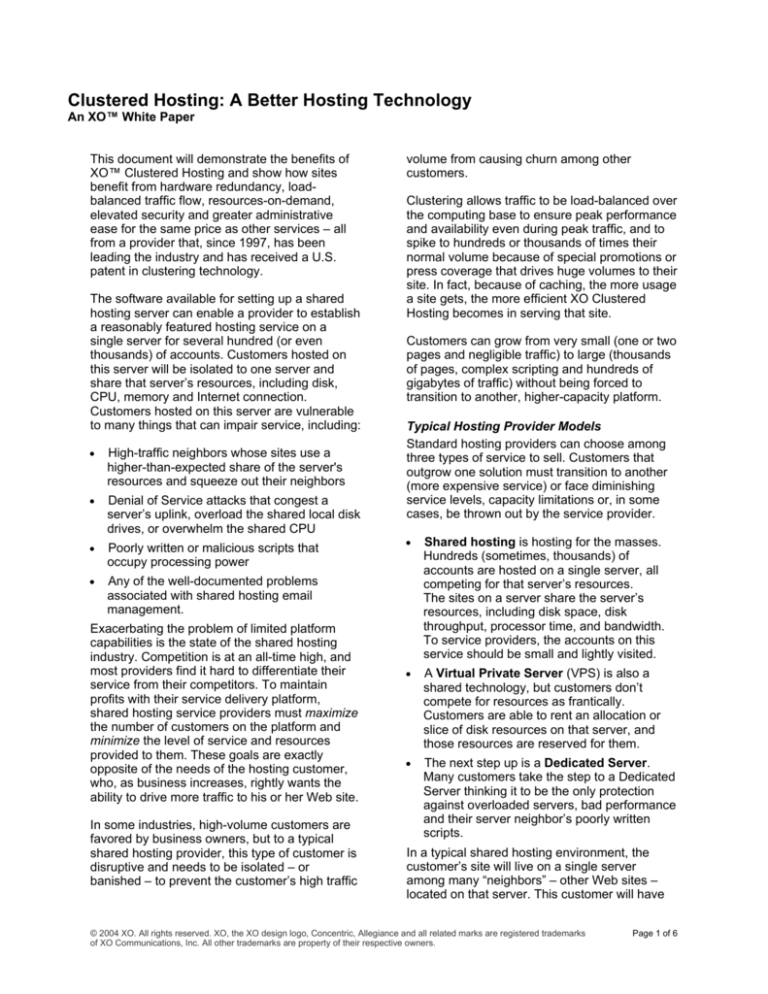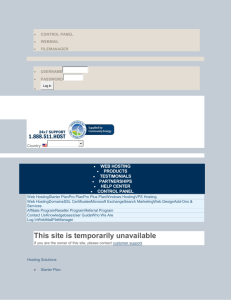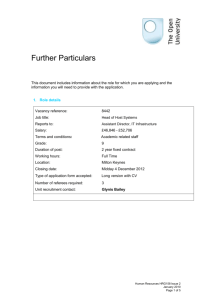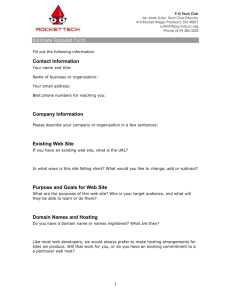
Clustered Hosting: A Better Hosting Technology
An XO™ White Paper
This document will demonstrate the benefits of
XO™ Clustered Hosting and show how sites
benefit from hardware redundancy, loadbalanced traffic flow, resources-on-demand,
elevated security and greater administrative
ease for the same price as other services – all
from a provider that, since 1997, has been
leading the industry and has received a U.S.
patent in clustering technology.
The software available for setting up a shared
hosting server can enable a provider to establish
a reasonably featured hosting service on a
single server for several hundred (or even
thousands) of accounts. Customers hosted on
this server will be isolated to one server and
share that server’s resources, including disk,
CPU, memory and Internet connection.
Customers hosted on this server are vulnerable
to many things that can impair service, including:
•
High-traffic neighbors whose sites use a
higher-than-expected share of the server's
resources and squeeze out their neighbors
•
Denial of Service attacks that congest a
server’s uplink, overload the shared local disk
drives, or overwhelm the shared CPU
•
Poorly written or malicious scripts that
occupy processing power
•
Any of the well-documented problems
associated with shared hosting email
management.
Exacerbating the problem of limited platform
capabilities is the state of the shared hosting
industry. Competition is at an all-time high, and
most providers find it hard to differentiate their
service from their competitors. To maintain
profits with their service delivery platform,
shared hosting service providers must maximize
the number of customers on the platform and
minimize the level of service and resources
provided to them. These goals are exactly
opposite of the needs of the hosting customer,
who, as business increases, rightly wants the
ability to drive more traffic to his or her Web site.
In some industries, high-volume customers are
favored by business owners, but to a typical
shared hosting provider, this type of customer is
disruptive and needs to be isolated – or
banished – to prevent the customer’s high traffic
volume from causing churn among other
customers.
Clustering allows traffic to be load-balanced over
the computing base to ensure peak performance
and availability even during peak traffic, and to
spike to hundreds or thousands of times their
normal volume because of special promotions or
press coverage that drives huge volumes to their
site. In fact, because of caching, the more usage
a site gets, the more efficient XO Clustered
Hosting becomes in serving that site.
Customers can grow from very small (one or two
pages and negligible traffic) to large (thousands
of pages, complex scripting and hundreds of
gigabytes of traffic) without being forced to
transition to another, higher-capacity platform.
Typical Hosting Provider Models
Standard hosting providers can choose among
three types of service to sell. Customers that
outgrow one solution must transition to another
(more expensive service) or face diminishing
service levels, capacity limitations or, in some
cases, be thrown out by the service provider.
•
Shared hosting is hosting for the masses.
Hundreds (sometimes, thousands) of
accounts are hosted on a single server, all
competing for that server’s resources.
The sites on a server share the server’s
resources, including disk space, disk
throughput, processor time, and bandwidth.
To service providers, the accounts on this
service should be small and lightly visited.
•
A Virtual Private Server (VPS) is also a
shared technology, but customers don’t
compete for resources as frantically.
Customers are able to rent an allocation or
slice of disk resources on that server, and
those resources are reserved for them.
•
The next step up is a Dedicated Server.
Many customers take the step to a Dedicated
Server thinking it to be the only protection
against overloaded servers, bad performance
and their server neighbor’s poorly written
scripts.
In a typical shared hosting environment, the
customer’s site will live on a single server
among many “neighbors” – other Web sites –
located on that server. This customer will have
© 2004 XO. All rights reserved. XO, the XO design logo, Concentric, Allegiance and all related marks are registered trademarks
of XO Communications, Inc. All other trademarks are property of their respective owners.
Page 1 of 6
no recourse against the malfeasance of his
neighbors that bring harm to their shared server.
Essentially, each server is a lifeboat to the
customers that are homed to that server. The
Problem
Cause
Provider sold too many
accounts on the server
Resource
problems
(Disk, RAM,
CPU, or
bandwidth)
Runaway or malicious
script running on your
server (not necessarily
your script)
Denial of Service attack to
a site on your server (not
necessarily your site)
Site hacked by a customer
on the same server
Security
Problems
Site hacked from outside
Increased storage of an
aged user base
Email
problems
Email spikes, loops, and
bombs constrained to a
single server, causing mail
to be delayed or lost for
other customers
Non-redundant local
storage causes data loss
after routine drive failure.
more customers, the more vulnerable that server
will be to overuse. As long as no one rocks the
boat, there won’t be a problem, but many things
can rock the boat:
Impact
• Degraded
level of
service
• Server
crashing
• Web site
ti
• Server
crashing
• Security
risks
• Server
unavailable
for your
traffic.
•
Data
security
breach
•
Loss of
confidential
information
• Data
security
breach
• Loss of
confidential
information
• Server
overloaded
(see above)
• Mail delays
• Mail loss
• Mail loss
Potential Solution
Move accounts to new server; add
processors or RAM to server. Both
require downtime and possible customer
involvement with re-addressing or
modification of scripts due to hard-coded
file locations changing.
Stop process or reboot server.
Preventative measures can be limiting
the CPU cycles that a script can use or
limiting the types of scripts allowed
Firewall or other protocol filters; higher
bandwidth Internet pipes
Using the typical open-source or
commercial off-the-shelf solutions. No
stock solution to protecting customers
inside the operating system – this
requires custom software solutions.
Firewall or other protocol filters; tightly
locked down server systems; aggressive
patching procedures (which often result
in customer downtime since no ability to
fail over during maintenance exists)
Move users to a new box; take the box
down to add storage or delete email.
Move customers to a new box.
Cry. Repeat.
© 2004 XO. All rights reserved. XO, the XO design logo, Concentric, Allegiance and all related marks are registered trademarks
of XO Communications, Inc. All other trademarks are property of their respective owners.
Page 2 of 6
The typical hosting service model has many single points of failure.
XO™ Clustered Hosting
Clustering technology is designed to eliminate
the problems inherent with typical shared
hosting infrastructures. This technology provides
customers with a “clustered” handling of
security, load balancing, and necessary Web
site resources.
The XO Clustered Hosting platform is datadriven, which means that no human interaction
is needed to provision a new account to the
platform. Immediately upon account purchase,
the customer can begin using hosting resources
such as DNS Manager, email services (Web
Mail, POP3 and IMAP), FTP, FrontPageTM,
MySQL™ and Shell access.
Since customers can add additional allocations
for disk, traffic, and processor cycles, these
allocations – received at sign-up – are a function
of the monthly charge and not a physical
limitation of the platform.
XO™ Clustered Hosting “virtualizes” the
resources beyond the limits of one physical
box. Customers are not limited to one server.
They share the processing power of many
servers and their applications are distributed in
real-time. This means that they can purchase as
much computing power as they want from a
virtually inexhaustible source, since even the
largest customer never consumes more than a
fraction of a percent of the total server pool.
Customer account changes (to add new
resources or change settings) are propagated
immediately to every server in the cluster.
This is different from typical shared hosting
architectures that usually require changes to a
configuration file that becomes live after the
server is rebooted during off hours, or are
pushed on a cyclic basis every few hours.
© 2004 XO. All rights reserved. XO, the XO design logo, Concentric, Allegiance and all related marks are registered trademarks
of XO Communications, Inc. All other trademarks are property of their respective owners.
Page 3 of 6
Clustered Hosting Topology
Diverse, High
Bandwidth
Internet Feeds
Clustered Servers
1
2
Cisco 12000 SERIES
3
4
0
1
2
3
CSCO
CSC1
4
5
6
5
7
6
Internet
1
7
2
8
Cisco 12000 SERIES
FAN
STATUS
3
9
4
0
1
2
3
CSCO
CSC 1
4
5
6
7
5
6
7
8
FAN
STATUS
9
Power Supply 1
Pow
erSupply 2
Catalyst 6500 S ER IE S
PowerSupply 1
Power Supply 2
Catal ys t 6500 SE RIES
Redundant
Routing and
Switching
S
u
S
n
u
S
n
u
S
n
u
S
n
u
S
n
u
S
n
u
n
EN
TE
4
2
RP
0
RIR
EN
SE
TE
4
2
RP
0
RIR
EN
SE
TE
4
2
RP
0
RIR
EN
SE
TE
4
2
RP
0
RIR
EN
SE
TE
4
2
RP
0
RIR
EN
SE
TE
4
2
RP
0
RIR
EN
SE
TE
4
2
RP
0
RIR
SE
S
u
S
n
u
S
n
u
S
n
u
S
n
u
S
n
u
S
n
u
n
EN
TE
4
2
RP
0
RIR
EN
SE
TE
4
2
RP
0
RIR
EN
SE
TE
4
2
RP
0
RIR
EN
SE
TE
4
2
RP
0
RIR
EN
SE
TE
4
2
RP
0
RIR
EN
SE
TE
4
2
RP
0
RIR
EN
SE
TE
4
2
RP
0
RIR
SE
S
u
S
n
u
S
n
u
S
n
u
S
n
u
S
n
u
S
n
u
n
EN
TE4
2
RP
0
RIR
EN
SE
TE4
2
RP
0
RIR
EN
SE
TE4
2
RP
0
RIR
EN
SE
TE4
2
RP
0
RIR
EN
SE
TE4
2
RP
0
RIR
EN
SE
TE4
2
RP
0
RIR
EN
SE
TE4
2
RP
0
RIR
SE
S
u
S
n
u
S
n
u
S
n
u
S
n
u
S
n
u
S
n
u
n
EN
TE
4
2
RP
0
RIR
EN
SE
TE
4
2
RP
0
RIR
EN
SE
TE
4
2
RP
0
RIR
EN
SE
TE
4
2
RP
0
RIR
EN
SE
TE
4
2
RP
0
RIR
EN
SE
TE
4
2
RP
0
RIR
EN
SE
TE
4
2
RP
0
RIR
SE
Highly
Available,
Network
Attached
Storage
All servers serve all sites
Load Balancing and
Security done here
Clustered Hosting serves Web sites, email and DNS from a secure, reliable, redundant, load-balanced platform.
As this graphic shows, traffic is dynamically
load-balanced across all of the web servers, so
the impact of an increased load is diluted.
Capacity management can be achieved by
adding additional servers to the cluster, and this
can be done in a matter of hours with no impact
to existing customers. By being served from a
cluster of servers instead of confined to one,
your neighbor’s usage does not impact your
Web site response time or available resources.
XO™ Clustered Hosting preserves the
benefits of Windows hosting services within
the robust, clustered framework. Windows /
IIS provides a highly robust and feature-rich
hosting environment, but experiences the same
limitations as other hosting options when
implemented in a shared environment, including
local vulnerabilities, scalability and capacity
management limitations, and hardware points of
failure around single servers and local storage.
XO Clustered Hosting allows Windows servers
to share in the benefits of enhanced security,
network storage and real-time fail-over.
XO Clustered Hosting is operating-system
agnostic. It was designed to deliver its loadbalanced secure service to both Windows and
UNIX applications, and both end-user solutions
share the benefits of the years of development
and engineering within XO Clustered Hosting.
‘Shared’ Windows solutions without this level of
investment and architecture suffer from the
same problems described above.
Clustering ensures that web servers are
available to handle huge spikes in traffic. If a site
handles traffic of more than 100GB a day or a
month, each request will be served
appropriately.
XO Clustered Hosting places controls and
protections on the scripts that customers
run as part of their Web sites. A poorly-written
script can cripple a server. XO Clustered
Hosting secures and assigns script processes to
individual accounts by isolating script processes
within the “Virtual Domain Environment” (VDE).
The VDE measures script processing time in
Resource Units (RUs), which is a measure of
CPU run time. RUs are generously allocated
and can be added in real time by the account’s
administrator. The VDE protects accounts from
their neighbors and helps administrators
recognize the resources used by their script
processes. While a poorly written script can
cripple a normal shared server, the VDE isolates
script’s process to the individual account’s
resources and isolates scripts with loops and
critical flaws to the account which owns them.
This ensures that a bad developer doesn’t harm
anybody but his own account and solves the
problem of the bad developer “neighbor.”
The VDE’s purpose is much like the process
isolation mechanisms of a Virtual Dedicated
Server (VDS); however, it has significant
differences.
© 2004 XO. All rights reserved. XO, the XO design logo, Concentric, Allegiance and all related marks are registered trademarks
of XO Communications, Inc. All other trademarks are property of their respective owners.
Page 4 of 6
•
•
A VDS runs on one server and partitions the
one server’s resources. An account on a
VDS can only use the portion of a server’s
resources it has been allocated. In
comparison, the VDE that has access to the
computing power of the entire cluster.
Customers can consume multiple
processors’ worth of CPU when needed and
no idle resources when not in use. The VDE
runs on all servers in the cluster and is
dynamically scalable; unlike traditional
virtual dedicated servers, there is no static
configuration per site and no startup time to
transition to the VDE for individual site
events.
VDS solutions are vulnerable to maximum
load failures at large load times, and
typically are not sufficient for a site which
either consumes huge processing resources
or may expect a spike due to a successful
ad campaign or press release.
Disk space and bandwidth are also restricted so
that users cannot use more than their allotment.
However, if an account needs more of any of
these resources, it is available to them in real
time through the administrative interface. All
accounts include notifications as resource use
reaches limits. Additionally, real-time log and
usage reporting ensures account administrators
understand their resource utilization at any time.
Security is a fundamental part of XO
Clustered Hosting, not an afterthought.
There are multiple tiers of security protections
integrated into the XO Clustered Hosting
platform. In a typical hosting environment, the
security layer is usually not integrated in the
platform. The stock solutions used for shared
hosting do not solve core issues around
integrating security between the application and
the operating system. At best, most typical hosts
will implement a firewall solution, and
weaknesses inherent with the operating system
will remain exploitable to those that penetrate
the firewall. In popular vernacular: they have a
hard, crunchy outside and a soft, chewy inside.
XO Clustered Hosting is designed from the
ground up to provide Web services securely and
efficiently. Its network layer protections employ
intelligent routing, redundant switching fabric
and built in firewall and proxy technology. XO
protects against the traditional sorts of attacks
aimed at IIS and/or Apache and thus avoids the
constant scramble that traditional hosts have to
do whenever a new vulnerability is announced:
the race to see if systems can be patched before
exploit scripts are published.
Our internal designs also prevent the sorts of
internal attacks that are endemic on shared
platforms where customers have root access
and can, for example, exploit file permissions
that are incorrectly set by other account holders
or use the frequent internal holes inside
operating systems.
XO Clustered Hosting provides considerable
advantages over traditional hosting architectures
in mitigating Denial of-Service and other network
attacks because such attacks can be dispersed
over a large pool of servers, and if individual
hardware components are impacted by such
attacks, they automatically fall out of traffic
handling during the attack.
As discussed above, the VDE grants sites the
right to use the entirety of the hosting cluster’s
file serving resources for scripts while account
limits protect the platform and the community of
users from the impacts of a poorly designed
script or site. Essentially, the VDE enforces the
social impact of “neighbors’” poor design skills.
Lastly, XO provides the ability for the customer
to secure themselves better. Traditionally, a
hosting provider will provide a single login for file
system access which must be shared by all the
people with access needs. These shared
passwords are disasters waiting to happen; they
are usually weak and rarely changed properly
when staffing changes.
XO Clustered Hosting allows for unlimited
access levels to be created and managed by
account administrators, which enables users to
have finely-tuned access rights only to the set of
files or resources they need. When a user is no
longer allowed access, one configuration
change will disable all their rights without
impacting others. Thus people are not forced to
have greater privileges than they need, which
leads to weak security.
The New Hosting Marketplace
Web site administrators looking for reliable
hosting for sites doing 1GB daily or more than
100GB of monthly traffic should investigate the
benefits of XO Clustered Hosting.
© 2004 XO. All rights reserved. XO, the XO design logo, Concentric, Allegiance and all related marks are registered trademarks
of XO Communications, Inc. All other trademarks are property of their respective owners.
Page 5 of 6
Platform Scalability and Performance
•
Accounts are not resident on any single
server; they share the computing power of
the cluster, so resources are virtually
limitless.
•
Clustering ensures that web servers are
available to handle huge spikes in traffic and
processing demands from successful sites.
•
Poorly-written scripts won’t cripple
neighboring accounts. Scripts are isolated,
monitored and restricted to the account’s
available CPU cycles.
•
Storage, bandwidth and CPU are spread
across the cluster, ensuring web site
responsiveness and scalability.
•
Services are not local to a server, so loss of
a server is not fatal to the overall service.
Security
•
Firewall protection and access control are
natively integrated into the platform
•
Accounts are isolated from one another.
Your service and data are safe.
•
Scripts operate in a virtual development
environment. Rogue scripts do not have the
opportunity to take down servers.
Price
•
XO Clustered Hosting is a fraction the cost
of dedicated or VPS solutions and equal to
the cost of lesser shared hosting services.
Account control
•
Real-time provisioning of accounts,
resources and service changes
•
Account administrators have single login
online access to all of the functions that they
need, like adding users and resources,
uploading changes, modifying publishing
rights and DNS, managing databases, etc.
•
Reports are available online to see
bandwidth and disc usage, site hits and
other critical account management statistics.
About XO Communications
XO Communications is a leading provider of
national and local telecommunications services
to businesses, large enterprises and
telecommunications companies. XO offers a
complete portfolio of services, including local
and long distance voice, dedicated Internet
access, private networking, data transport, and
Web hosting services as well as bundled voice
and Internet solutions.
Redundancy
•
All functions have inherent failover because
all servers serve all functions. Functions
such as load balancing and firewall are all in
redundant configuration.
XO provides these services over an advanced,
national facilities-based IP network and serves
more than 70 metropolitan markets across the
United States. For more information, visit
www.xo.com.
© 2004 XO. All rights reserved. XO, the XO design logo, Concentric, Allegiance and all related marks are registered trademarks
of XO Communications, Inc. All other trademarks are property of their respective owners.
Page 6 of 6






